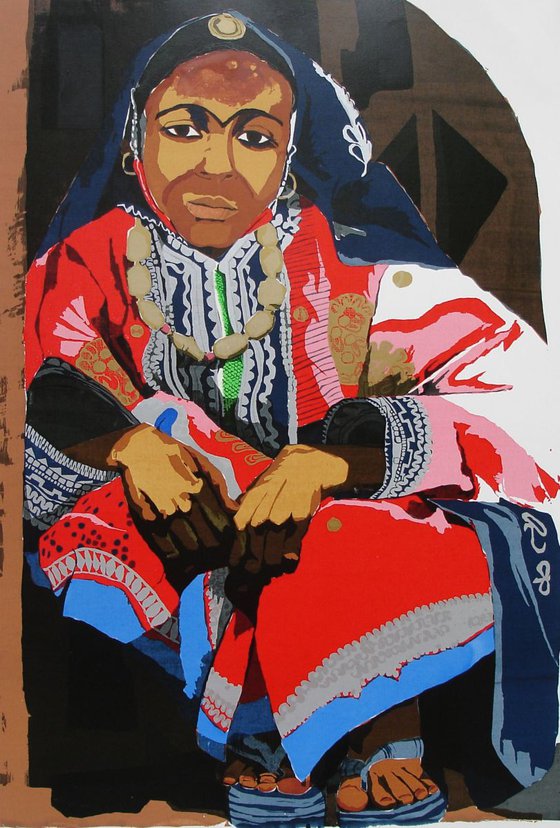- By medium
- By subject
- By budget
- Sales
- Gift cards
- Discover all art
- Artists
- Editors’ picks
- Ideas
Artwork description:
This beautiful child is almost life size in this original silk screen print. Many were damaged in a hurricane ( Our roof spit in half!), so only a few left.
I was invited to watch the last large camel caravan that passes through the Empty Quarter on the Eastern side of the dunes, the Sharkia. I loved it there as it reminded me of the White Sands of New Mexico---but on the grandest of scales.
Women and children had to climb onto a roof top to watch as the Bedoin soon organized camel races down the main street! Before I was herded onto the roof I saw this girl, about four years old, and asked if I could take her photo. She crouched down in a doorway, so I crouched too and took the picture. It turned out the child had malaria and was very tired. I felt terrible, and it was always a problem for me asking for photographs, as I do not like to impose. But I really felt the need to capture the essence of this period in Omani history.
Although the clothing is sewn from modern materials and she is wearing flip flops, the face is painted in hennas and tumeric with other spices. The eyebrows are drawn together with Khol. Each tribe in Oman had their own special face patterns and colors. Feet, hands and nails, of both toes and fingers, were covered in a thick henna paste and sealed tightly in plastic bags to make the dye penetrate the nails and skin. Henna patterns were usually for brides, from what I saw, the fancy and delicate patterns were confined to India back then. There were a few very simple chin tattoos, but the only thing they did ona large scale, was the big holes in the ears, which are so fashionable now.
This girl is wearing a chin strap to which very large and heavy earrings were attached to prevent tearing of the ear lobes. As babies, ears were pierced, both boys and girls. The holes were gradually enlarged using different sizes of twigs until the child had holes large enough to wear earrings from the family pool of jewelry.
This girl's delicate African features come from the ismand of Zanzibar, a Protectorate of Oman. Oman was the last slave trading nation, into the 20th century. Africans were captured and held on Zanzibar. They were given a choice, take the Faith or be sold inot an unknown fate. Many took the Faith and are powerful tribes within Oman today.
Materials used:
Archival paper and Sericol inks
Tags:
#wahiba sands #middle east tribal costume #realistic child portrait #exotic brilliant colors #tribal dress #sultanate of omanAlmintirib II Wahiba Sands Empty Quarter Sultanate of Oman (1981) Screenprint
by Charmaine Hall
£6,531.08
- Screenprint on Paper on board
- From a limited edition of 56
- Size: 41.91 x 66.04 x 2.54cm (unframed) / 50.8 x 73.66cm (actual image size)
- Signed and numbered on the front
- Style: Photorealistic
- Subject: People and portraits
Loading
Artwork description
This beautiful child is almost life size in this original silk screen print. Many were damaged in a hurricane ( Our roof spit in half!), so only a few left.
I was invited to watch the last large camel caravan that passes through the Empty Quarter on the Eastern side of the dunes, the Sharkia. I loved it there as it reminded me of the White Sands of New Mexico---but on the grandest of scales.
Women and children had to climb onto a roof top to watch as the Bedoin soon organized camel races down the main street! Before I was herded onto the roof I saw this girl, about four years old, and asked if I could take her photo. She crouched down in a doorway, so I crouched too and took the picture. It turned out the child had malaria and was very tired. I felt terrible, and it was always a problem for me asking for photographs, as I do not like to impose. But I really felt the need to capture the essence of this period in Omani history.
Although the clothing is sewn from modern materials and she is wearing flip flops, the face is painted in hennas and tumeric with other spices. The eyebrows are drawn together with Khol. Each tribe in Oman had their own special face patterns and colors. Feet, hands and nails, of both toes and fingers, were covered in a thick henna paste and sealed tightly in plastic bags to make the dye penetrate the nails and skin. Henna patterns were usually for brides, from what I saw, the fancy and delicate patterns were confined to India back then. There were a few very simple chin tattoos, but the only thing they did ona large scale, was the big holes in the ears, which are so fashionable now.
This girl is wearing a chin strap to which very large and heavy earrings were attached to prevent tearing of the ear lobes. As babies, ears were pierced, both boys and girls. The holes were gradually enlarged using different sizes of twigs until the child had holes large enough to wear earrings from the family pool of jewelry.
This girl's delicate African features come from the ismand of Zanzibar, a Protectorate of Oman. Oman was the last slave trading nation, into the 20th century. Africans were captured and held on Zanzibar. They were given a choice, take the Faith or be sold inot an unknown fate. Many took the Faith and are powerful tribes within Oman today.
Materials used:
Archival paper and Sericol inks
Tags:
#wahiba sands #middle east tribal costume #realistic child portrait #exotic brilliant colors #tribal dress #sultanate of oman14 day money back guaranteeLearn more

